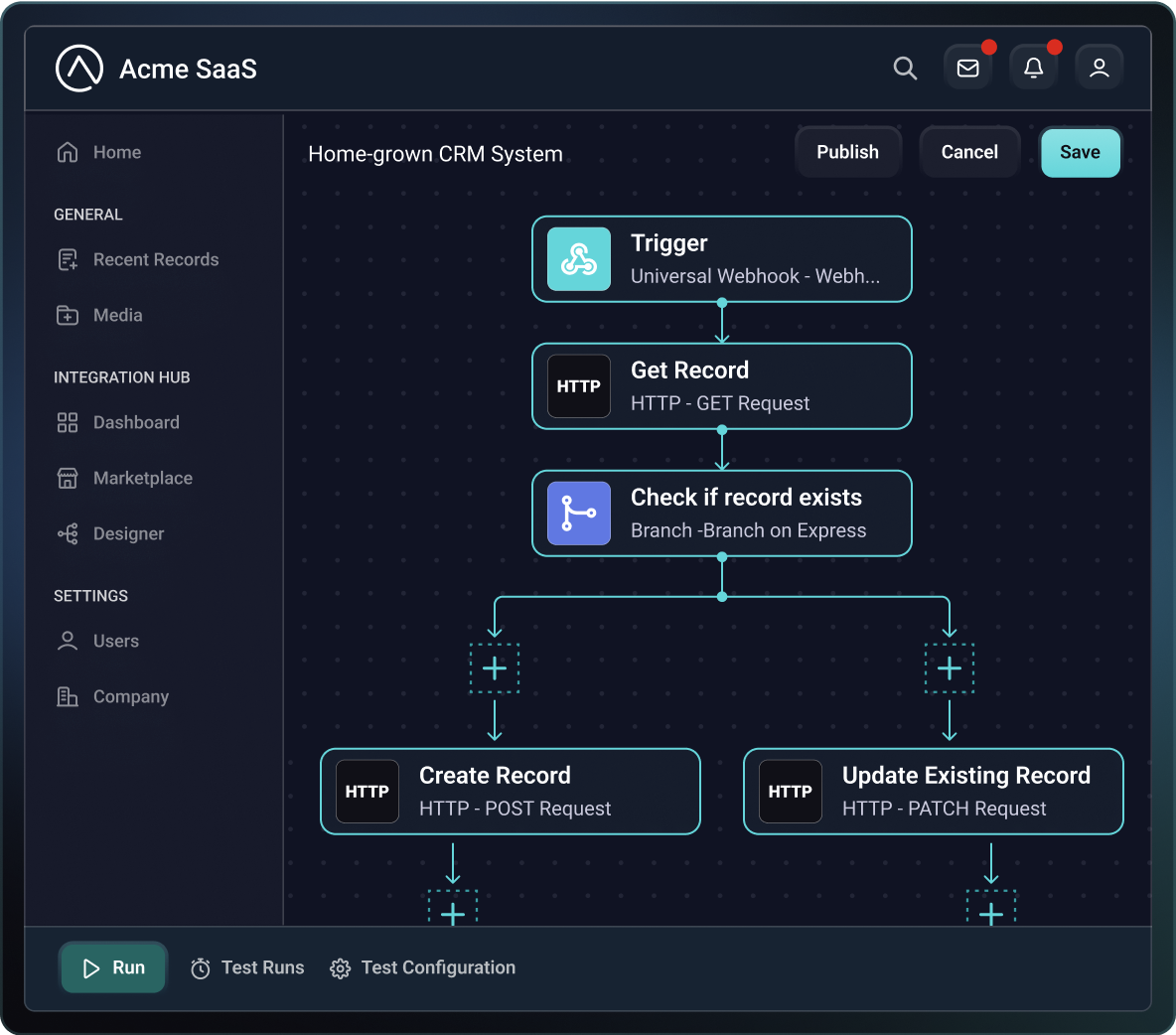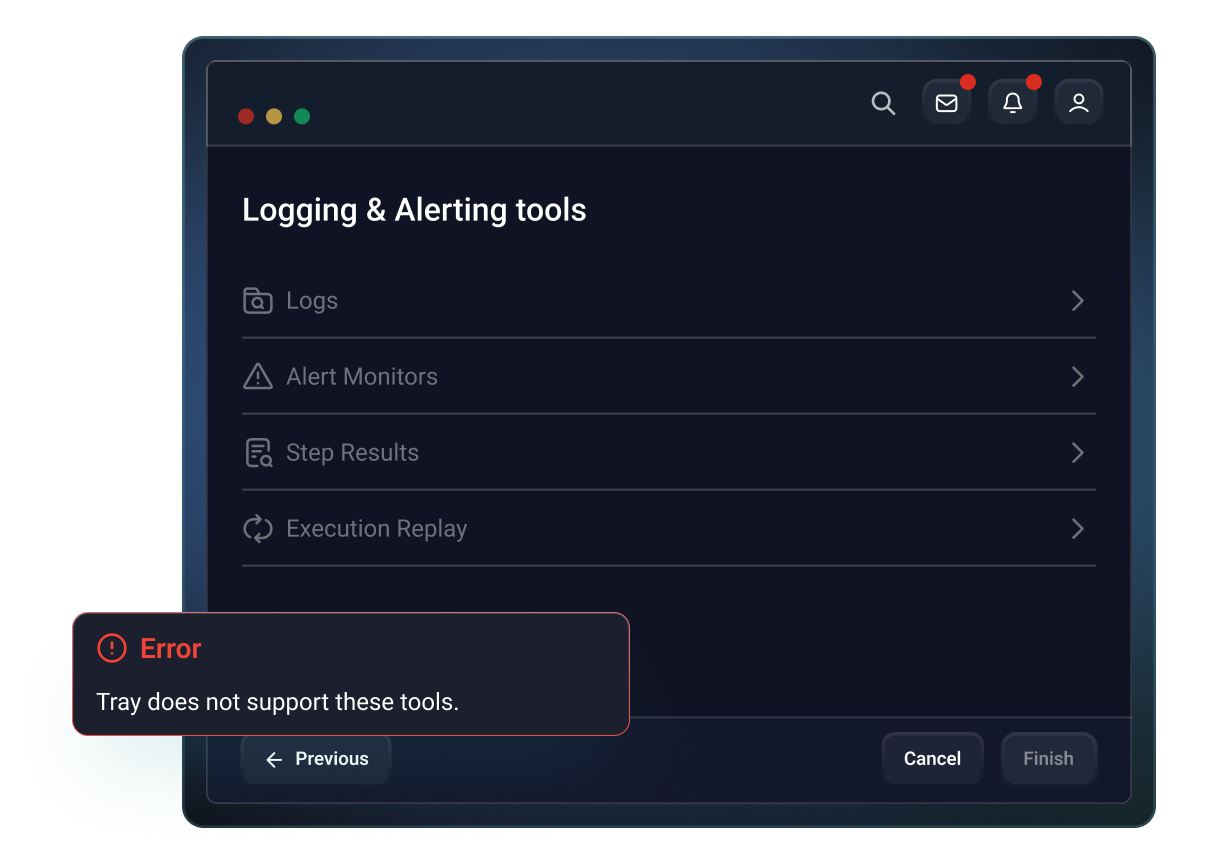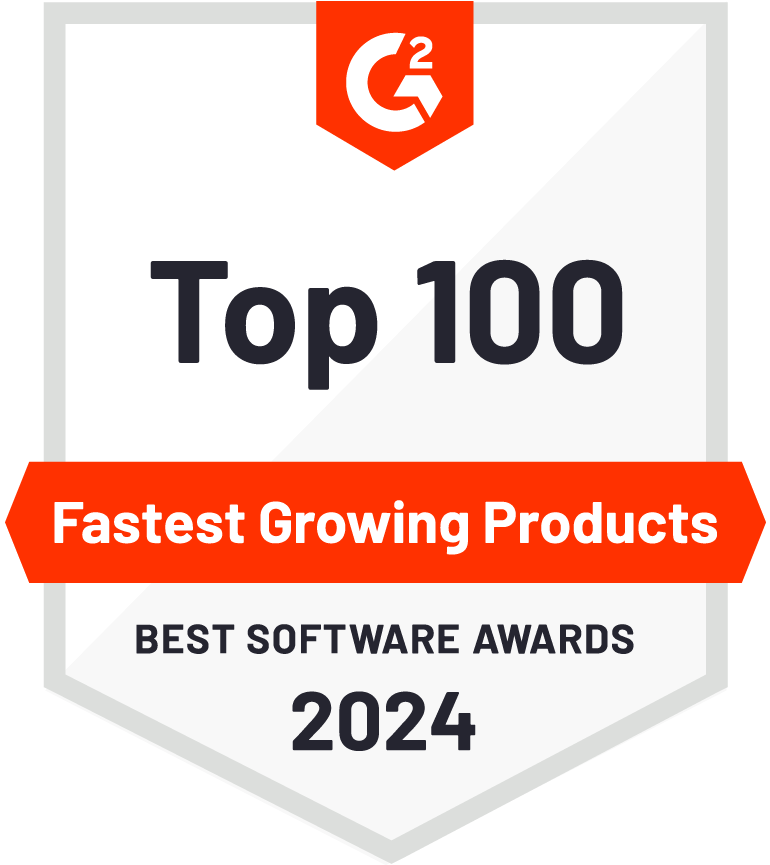Prismatic leads in satisfaction for embedded iPaaS!
What are the differences between Prismatic and Tray Embedded?
Prismatic's embedded iPaaS is a purpose-built, cloud-native B2B SaaS integration platform best suited for SaaS teams that need to create everything from simple to highly complex integrations. It provides a first-class UX for non-devs (via the low-code designer) and devs (via code-native integrations).
Tray's embedded iPaaS is a B2B SaaS integration platform best suited for companies needing integrations that can be assembled from the platform's available connectors. While it includes a way to build integrations with code, that approach is geared toward allowing devs to move more quickly to create integrations from existing connectors and components rather than writing code as needed to solve complex integration needs.
 | |||
|---|---|---|---|
| Low-code integration designer | |||
| Embedded integration marketplace | |||
| Pre-built connector library | |||
| Custom connector SDK | Full Node.js environment | HTTP-only low-code custom connector builder | |
| Embedded integration designer for end users | |||
| Granular versioning control of integrations and their connectors | |||
| Complete customer management console environment | |||
| 100% of application functionality available through API | |||
| Designed to fit into existing CI/CD workflows | |||
| Command line interface (CLI) | |||
| Dev-friendly docs with code examples in GitHub report | |||
| Self-service support tools for logging and alerting | |||
| Flexible cloud deployments | Multi-region, private cloud | ||
- Low-code integration designer
- Embedded integration marketplace
- Pre-built connector library
- Custom connector SDKFull Node.js environment
- Embedded integration designer for end users
- Granular versioning control of integrations and their connectors
- Complete customer management console environment
- 100% of application functionality available through API
- Designed to fit into existing CI/CD workflows
- Command line interface (CLI)
- Dev-friendly docs with code examples in GitHub report
- Self-service support tools for logging and alerting
- Flexible cloud deploymentsMulti-region, private cloud

- Low-code integration designer
- Embedded integration marketplace
- Pre-built connector library
- Custom connector SDKHTTP-only low-code custom connector builder
- Embedded integration designer for end users
- Granular versioning control of integrations and their connectors
- Complete customer management console environment
- 100% of application functionality available through API
- Designed to fit into existing CI/CD workflows
- Command line interface (CLI)
- Dev-friendly docs with code examples in GitHub report
- Self-service support tools for logging and alerting
- Flexible cloud deployments
Prismatic beautifully supports the model we wanted: technical support staff configure new instances of known integrations; software engineers get involved when there's something new; support staff can monitor what's happening day-to-day. Meanwhile, we can focus engineering cycles on adding value for our customers.

With Prismatic, we're able to deliver integrations in far less time while streamlining our engineering effort. Prismatic has given us the ability to more widely build integrations across our teams. It has also allowed our customer-facing teams to handle customer-specific deployment.


Prismatic has been a game-changer for our team. The platform's intuitive low-code builder, marketplace and robust monitoring capabilities allow us to deliver complex integrations faster and more reliably than ever before. Whether quickly wiring up an integration using pre-built components or developing custom logic, Prismatic gives us the flexibility we need.


We probably save 95% of engineering time, we've deployed far more integrations than we would have without Prismatic. Everyone gets it; everyone understands that we can integrate wherever we need to, and that's quite a powerful thing.


The speed to market, the development costs, the ease of usability, the variety of integrations, the ability to customize it, and then also make a seamless marketplace. It's the whole package. Prismatic has changed the game, certainly 100% for us.


We've been able to see a roughly 50% increase in new customer acquisition simply by that factor of reducing time on our maintenance. My development team can now focus on new integrations and new automations.


After evaluating numerous embedded iPaaS vendors, Prismatic emerged as the clear leader for scaling customer integrations. Their comprehensive toolset not only enables access to diverse data sources but empowers our customers to build, deploy, and manage their own integrations with confidence.


Prismatic has enabled FMX to be efficient, consistent, and reliable in our integrations with third party systems. Prismatic has quickly become the clear choice for all facets of our integration strategy, including the migration of current integrations from previous solutions. We are pleased to mention our partnership with Prismatic when discussing system integration with prospects, customers, and other solution providers.

Prismatic beautifully supports the model we wanted: technical support staff configure new instances of known integrations; software engineers get involved when there's something new; support staff can monitor what's happening day-to-day. Meanwhile, we can focus engineering cycles on adding value for our customers.

With Prismatic, we're able to deliver integrations in far less time while streamlining our engineering effort. Prismatic has given us the ability to more widely build integrations across our teams. It has also allowed our customer-facing teams to handle customer-specific deployment.


Prismatic has been a game-changer for our team. The platform's intuitive low-code builder, marketplace and robust monitoring capabilities allow us to deliver complex integrations faster and more reliably than ever before. Whether quickly wiring up an integration using pre-built components or developing custom logic, Prismatic gives us the flexibility we need.


We probably save 95% of engineering time, we've deployed far more integrations than we would have without Prismatic. Everyone gets it; everyone understands that we can integrate wherever we need to, and that's quite a powerful thing.


The speed to market, the development costs, the ease of usability, the variety of integrations, the ability to customize it, and then also make a seamless marketplace. It's the whole package. Prismatic has changed the game, certainly 100% for us.


We've been able to see a roughly 50% increase in new customer acquisition simply by that factor of reducing time on our maintenance. My development team can now focus on new integrations and new automations.


After evaluating numerous embedded iPaaS vendors, Prismatic emerged as the clear leader for scaling customer integrations. Their comprehensive toolset not only enables access to diverse data sources but empowers our customers to build, deploy, and manage their own integrations with confidence.


Prismatic has enabled FMX to be efficient, consistent, and reliable in our integrations with third party systems. Prismatic has quickly become the clear choice for all facets of our integration strategy, including the migration of current integrations from previous solutions. We are pleased to mention our partnership with Prismatic when discussing system integration with prospects, customers, and other solution providers.

Prismatic beautifully supports the model we wanted: technical support staff configure new instances of known integrations; software engineers get involved when there's something new; support staff can monitor what's happening day-to-day. Meanwhile, we can focus engineering cycles on adding value for our customers.

With Prismatic, we're able to deliver integrations in far less time while streamlining our engineering effort. Prismatic has given us the ability to more widely build integrations across our teams. It has also allowed our customer-facing teams to handle customer-specific deployment.


Prismatic has been a game-changer for our team. The platform's intuitive low-code builder, marketplace and robust monitoring capabilities allow us to deliver complex integrations faster and more reliably than ever before. Whether quickly wiring up an integration using pre-built components or developing custom logic, Prismatic gives us the flexibility we need.


We probably save 95% of engineering time, we've deployed far more integrations than we would have without Prismatic. Everyone gets it; everyone understands that we can integrate wherever we need to, and that's quite a powerful thing.


The speed to market, the development costs, the ease of usability, the variety of integrations, the ability to customize it, and then also make a seamless marketplace. It's the whole package. Prismatic has changed the game, certainly 100% for us.


We've been able to see a roughly 50% increase in new customer acquisition simply by that factor of reducing time on our maintenance. My development team can now focus on new integrations and new automations.


After evaluating numerous embedded iPaaS vendors, Prismatic emerged as the clear leader for scaling customer integrations. Their comprehensive toolset not only enables access to diverse data sources but empowers our customers to build, deploy, and manage their own integrations with confidence.


Prismatic has enabled FMX to be efficient, consistent, and reliable in our integrations with third party systems. Prismatic has quickly become the clear choice for all facets of our integration strategy, including the migration of current integrations from previous solutions. We are pleased to mention our partnership with Prismatic when discussing system integration with prospects, customers, and other solution providers.

Prismatic is purpose-built for B2B SaaS
Prismatic has been wholly focused on B2B SaaS integrations since it was founded. Everything the platform provides, from the low-code and code-native flexibility to ensuring that end-users have unparalleled access to detailed integration status info, has grown out of an understanding that building, deploying, and managing B2B SaaS integrations is fundamentally different than doing those same tasks for integrations that exist within the enterprise.
Tray's embedded platform was initially built for the enterprise, with a toolset optimized for internal IT users. As a result, Tray has a very simple marketplace that can be embedded in a B2B SaaS app, but B2B SaaS companies must build detailed marketplaces and specific listings for integrations deployed to their end users.
Tray focuses primarily on its enterprise iPaaS rather than its embedded iPaaS.
 | |||
|---|---|---|---|
| Pre-built connector library | |||
| White-labeled integration marketplace | Simple marketplace only | ||
| Embedded integration designer | |||
- Pre-built connector library
- White-labeled integration marketplace
- Embedded integration designer

- Pre-built connector library
- White-labeled integration marketplaceSimple marketplace only
- Embedded integration designer
Hear from Prismatic customers
Devs can write code in Prismatic
Prismatic enables devs to use the same custom connector SDK that Prismatic uses internally to build connectors from your SaaS product to any app your customers use, regardless of their vertical.
Prismatic's code-native integration building experience is no less powerful. Devs can use their favorite IDEs with the code-native integrations SDK to build entire integrations in code.
Tray relies heavily on a low-code approach for developing integrations. And, if you build custom components with Tray, you must get Tray to publish them. In addition, Tray doesn't include a custom component SDK or its equivalent to facilitate custom component development.
 | |||
|---|---|---|---|
| Low-code builder | |||
| Custom code | Use any npm package or other library | Limited to wiring together existing code | |
| Custom connectors | Create for REST, SOAP, XML, GraphQL and other APIs | Can build, but must get Tray to publish | |
| Code-native integrations | |||
- Low-code builder
- Custom codeUse any npm package or other library
- Custom connectorsCreate for REST, SOAP, XML, GraphQL and other APIs
- Code-native integrations

- Low-code builder
- Custom codeLimited to wiring together existing code
- Custom connectorsCan build, but must get Tray to publish
- Code-native integrations
User experience
Prismatic built its platform with users in mind – your team and your customers. This user focus is visible from the low-code integration designer and code-native integration experience to the configuration wizard and the alerting and monitoring functions.
In addition, Prismatic provides its embedded workflow designer so you can empower your customers to build integrations. You can focus on the integrations that have broad appeal across your customer base while ensuring that your customers still have the one-off, custom integrations that are uniquely important to them.

Tray's embedded iPaaS (initially an enterprise iPaaS) has a UX optimized for IT personnel who build internal integrations, not for B2B SaaS personnel who deploy and support integrations or the customer end users. As a result, the UX could be smoother, particularly for the end users.
For example, when you deploy an integration in Tray, your customers don't have access to logging and alerting tools that will provide them with the detailed visibility necessary for them to service their own integrations.

Speak with an integration expert
What users say about Prismatic and Tray
Prismatic gets high marks for usability and relationships for embedded iPaaS. Customers also regularly praise Prismatic for its support and product flexibility.
Tray customers comment on how easily they can build integrations and the number of connectors available, but they also mention issues with software support and the difficulties of performing more complex functions such as data mapping.
For more details from G2 on how Prismatic compares to Tray and other embedded iPaaS, check out the most current quarterly G2 Grid Report.
"Being a lifelong engineer for high-scale applications, it's hard to relinquish the desire to build everything myself. Prismatic has created an incredibly powerful and flexible platform, built off scalable technologies, so you don't have to."
"Prismatic has been a joy to work with as a developer. The tool itself is clearly organized and offers a flexible outlook on code structure easily adaptable to a wide variety of integrations and use cases."
"I found Prismatic to be very straight forward to use and easy to code for. The team has a wealth of knowledge and made it easy to support what we were aiming for. The documentation is extensive and covers many use cases, giving step by step instructions or general solutions to common integration problems."
"Since using this platform for a few years I can still say it's amazing! The recent release of code native has also elevated our ability to craft exactly the integrations we want and was very exciting for our engineers. The integrations our team builds can be very complex, which code native allows us to build to."
"Prismatic is easy to use and supports a wide variety of integrations and most of these can be written with little or no coding knowledge, the documentation is very good and the highlight of all is the support team, they are very knowledgeable and they always answer the questions to the point and in the simplest way possible."
"Being a lifelong engineer for high-scale applications, it's hard to relinquish the desire to build everything myself. Prismatic has created an incredibly powerful and flexible platform, built off scalable technologies, so you don't have to."
"Prismatic has been a joy to work with as a developer. The tool itself is clearly organized and offers a flexible outlook on code structure easily adaptable to a wide variety of integrations and use cases."
"I found Prismatic to be very straight forward to use and easy to code for. The team has a wealth of knowledge and made it easy to support what we were aiming for. The documentation is extensive and covers many use cases, giving step by step instructions or general solutions to common integration problems."
"Since using this platform for a few years I can still say it's amazing! The recent release of code native has also elevated our ability to craft exactly the integrations we want and was very exciting for our engineers. The integrations our team builds can be very complex, which code native allows us to build to."
"Prismatic is easy to use and supports a wide variety of integrations and most of these can be written with little or no coding knowledge, the documentation is very good and the highlight of all is the support team, they are very knowledgeable and they always answer the questions to the point and in the simplest way possible."
"Being a lifelong engineer for high-scale applications, it's hard to relinquish the desire to build everything myself. Prismatic has created an incredibly powerful and flexible platform, built off scalable technologies, so you don't have to."
"Prismatic has been a joy to work with as a developer. The tool itself is clearly organized and offers a flexible outlook on code structure easily adaptable to a wide variety of integrations and use cases."
"I found Prismatic to be very straight forward to use and easy to code for. The team has a wealth of knowledge and made it easy to support what we were aiming for. The documentation is extensive and covers many use cases, giving step by step instructions or general solutions to common integration problems."
"Since using this platform for a few years I can still say it's amazing! The recent release of code native has also elevated our ability to craft exactly the integrations we want and was very exciting for our engineers. The integrations our team builds can be very complex, which code native allows us to build to."
"Prismatic is easy to use and supports a wide variety of integrations and most of these can be written with little or no coding knowledge, the documentation is very good and the highlight of all is the support team, they are very knowledgeable and they always answer the questions to the point and in the simplest way possible."
Security & Compliance
Prismatic is SOC 2 certified and compliant with GDPR, HIPAA, and CJIS. Prismatic is currently in the process of FedRAMP authorization.
Tray is also SOC 2 certified and compliant with GDPR, HIPAA, and CCPA.
GDPR compliance is required for companies doing business in Europe. HIPAA compliance covers the exchange of health-related data in the US. CJIS compliance is needed for companies doing public safety business with Federal, State, and Local governments. CCPA compliance covers California resident user data. FedRAMP authorization allows cloud service providers to do business with the federal government in the US.




Wrapping up
Prismatic's embedded iPaaS is a purpose-built, cloud-native B2B SaaS integration platform best suited for SaaS teams that must create highly configurable, reusable integrations for the full range of real-world integration complexity.
Tray's embedded platform is limited because of its origins as an enterprise iPaaS. These limitations include poor configurability of the default marketplace and the lack of an embedded integration designer. In addition, the platform's answer for code-native integration development does not have the true flexibility developers need to write whatever custom code they want.
Get a demo to see how Prismatic can enable rapid integration development for the full range of real-world integrations your customers need.
More Resources
Learn more about how Prismatic compares to other solutions.
Ready to get started?
Get a demo to see how Prismatic can help you deliver integrations fast.



